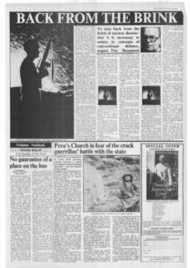Page 5, 19th August 1983
Page 5

Report an error
Noticed an error on this page?If you've noticed an error in this article please click here to report it.
Tags
Share
Related articles
Kangaroo Courts Of Lawless Peru
Peru Impatient For Reform
Pope Urges End To Peruvian Violence
Violence In Peru Hits Church
Peru Steps Up Action Against Guerrillas
Peru's Church in fear of the crack
guerrillas' battle with the state
A SPECIAL correspondent in Lima finds growing tension between a harsh government and determined guerrillas, with the Church in the middle.
A MAJOR escalation in urban sabotage by Peruvian guerrillas and increasing government repression have put the country's Catholic Church in a difficult position during 1983.
The Peruvian Bishops' Conference has made no public statements on the steppedup violence, but a few of the bishops and many priests, religious and lay leaders working among the poor are growing more and more concerned over the civilian government's response to the situation.
Some of the government's actions, they say, seem to be aimed at frustrating social action by the church to help the poor rather than at countering terrorism. Pastoral workers in Lima's slums say that police have picked up catechists and young community leaders in anti-terrorist sweeps in their areas.
Last January Peruvian President Fernando Belaunde Terry attacked "certain foreign priests who use the pulpit to stir up the masses," and his press office said that some priests were aiding the guerrillas, an accusation that the bishops' conference categorically denied.
Although guerrilla solutions find little support among church workers, many believe that the nation's most serious problem is not terrorism but the poverty of most of its citizens. At the end of May, Belaunde Terry declared a state of emergency and enacted tough new security measures in response to a major guerrilla offensive that included the sabotage of power lines, blacking out much of Lima and several coastal towns about 100 miles north of the capital.
The recent wave of blackouts and bombings in Lima and other parts of the country marked a widening of guerrilla activities outside its base in the central province of Ayacucho, located in the Andes Mountains. The guerrilla group causing all the problems is called Sendero Luminoso, Spanish for "Shining Path." Its ideological base springs from an effort to combine Maoist thoughts with the values of Peru's Andean Indian cultures.
Its founder-leader Is Abimael Carmen, a former philosophy professor at the University of Ayacucho. The ranks of the group, which broke off from the Communist Party more than a decade ago, are filled mainly with young peasants and students from the Ayacucho region. Critics, including other Peruvian Marxists, have said that the movement is elitist and dogmatic. Guzman has been compared to Cambodia's Pol Pot, whose rigidly ideological regime from 1975 to 1979 was responsible for the deaths of an estimated 2 million to 4 million people and the destruction of Cambodia's economic and social structures.
Sendero Luminoso has been most active in the neglected Ayacucho region, where average life expectancy is 45 years. However, a news blackout imposed on the area by its military governor has made it difficult to assess the degree of popular support for the guerrillas' aim of creating a pure communist society through years of "prolonged war." The blackout has also made it difficult to sort out conflicting aims of guerrilla or army responsibility for civilian deaths.
In urban areas the guerrilla organization's clandestine nature has thus far precluded mass backing. Some observers warn, however, that a combination of factors — Peru's deteriorating economy, food shortages due to unprecedented floods and droughts in different parts of the country, the government's hardening line, and the lack of any significant political opposition — could lead desperate Peruvians to view Sendero Luminoso as the only alternative.
Human rights advocates have accused the government of using torture and killing innocent peasants in Its counterinsurgency campaign in Ayacucho. They have also protested police round-ups of guerrilla suspects in Lima, saying people are being detained simply because they happen to be young and poor.
Archbishop Federico Richter of Ayacucho offered earlier this year to mediate between the government and the guerrillas, but otherwise he has not spoken publicly on the violence in his area. A few bishops have said that the political violence has its roots in the misery in which many Peruvians live.
Without badly needed social reforms, "it will be impossible to stop the acts of violence, because everyone has a limit," said Bishop Jose Dammed of Cajamarca.
"At a certain point people come to believe that the only solution is to violently do away with the status quo — without realizing that things could turn out worse," he said.
blog comments powered by Disqus











